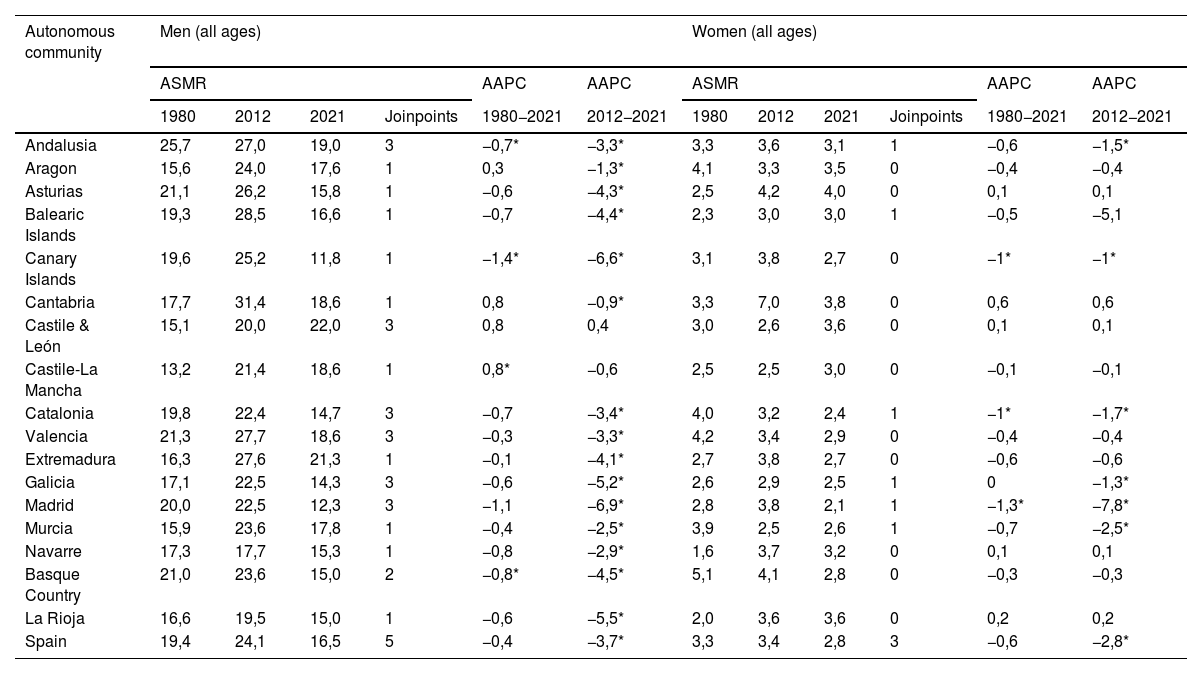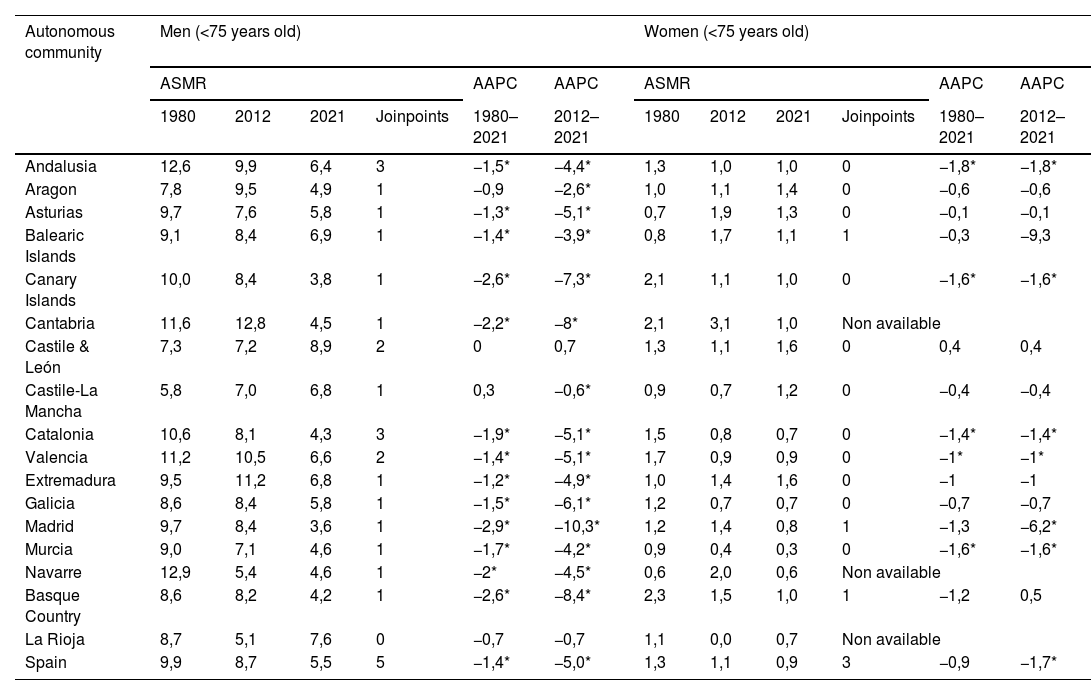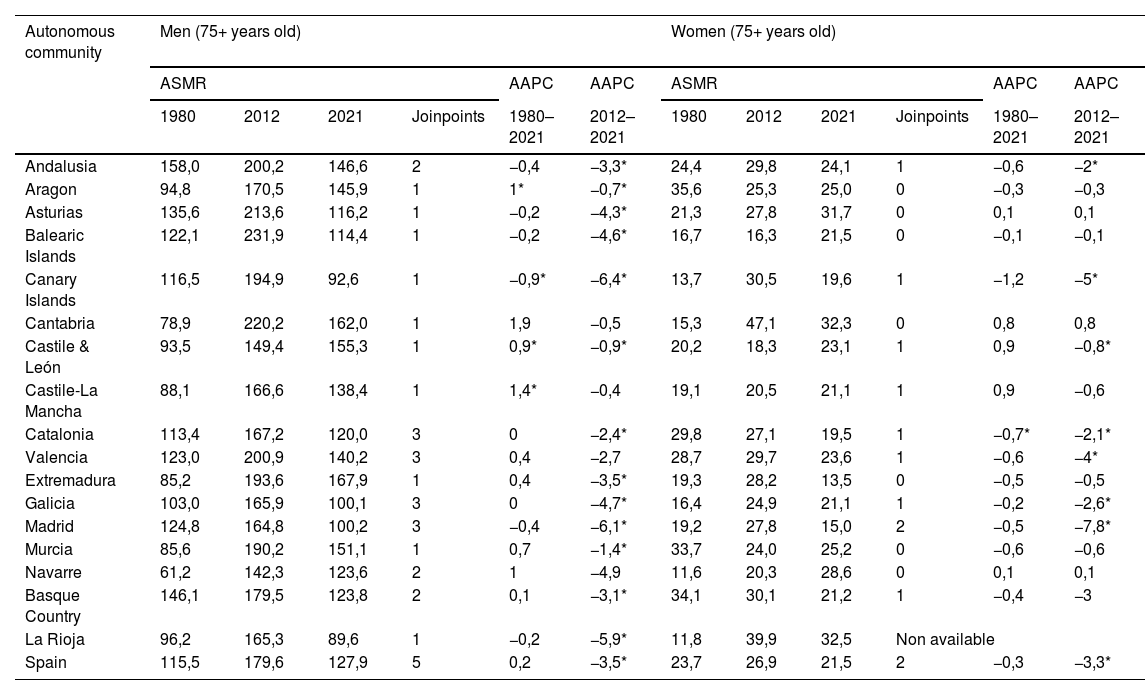We propose to update bladder cancer mortality rates in Spain from 1980 to 2021, by sex and age-group, by autonomous community (AC).
Materials and methodsThe public online databases of the National Statistical Institute were used to obtain data on population and bladder cancer mortality. Age-standardised mortality rates (ASMRs), all ages and truncated (<75 and ≥75) were estimated and reported as rates per 100,000 persons. Joinpoint regression software was used for estimation and trend analysis of ASMRs bladder cancer.
ResultsIn the last decade, the ASMR for bladder cancer (all ages, <75 years and ≥75 years) decreased significantly in Spain for both sexes. This trend was observed in 12 ACs for men and in 4 ACs (Andalusia, Canary Islands, Catalonia and Madrid) for women, although to different degrees. For men, ASMR remained stable in Castilla-León and La Rioja (<75 years), Cantabria, Castilla-La Mancha and Valencia (≥75 years) and the 2 Castilian regions (all ages). For women, ASMR also decreased in Valencia (<75 and ≥75), Castilla-León (≥75), Galicia (≥75 and all ages) and Navarre (<75 and all ages).
ConclusionOur results reveal significant variations in trends by AC, sex and age group, emphasizing the need for continued follow-up and targeted interventions to further reduce bladder cancer mortality rates in Spain.
Nos proponemos actualizar las tasas de mortalidad por cáncer de vejiga en España de 1980 a 2021, estandarizadas por sexo, grupo de edad y comunidades autónomas (CC. AA.).
Materiales y métodosSe utilizaron las bases de datos públicas en línea del Instituto Nacional de Estadística para obtener datos sobre población y mortalidad por cáncer de vejiga. Se calcularon las tasas de mortalidad estandarizadas por edad (TMEE) para todas las edades y las truncadas (< 75 y ≥ 75 años) y se presentaron como tasas por cada 100.000 personas. Se utilizó el modelo de regresión Joinpoint para el cálculo y análisis de las tendencias de las TMEE por cáncer de vejiga.
ResultadosEn la última década, las TMEE por cáncer de vejiga (todas las edades, < 75 años y ≥ 75 años) disminuyeron significativamente en España para ambos sexos. Esta tendencia se observó en 12 CC. AA. para los hombres y en 4 CC. AA. (Andalucía, Canarias, Cataluña y Madrid) para las mujeres, aunque en proporciones diferentes. Para los hombres, la TMEE permaneció estable en Castilla-León y La Rioja (< 75 años), Cantabria, Castilla-La Mancha y Valencia (≥ 75 años) y las 2 regiones castellanas (todas las edades). En el caso de las mujeres, las TMEE también disminuyeron en Valencia (< 75 y ≥ 75), Castilla-León (≥ 75), Galicia (≥ 75 y todas las edades) y Navarra (< 75 y todas las edades).
ConclusiónNuestros resultados revelan variaciones significativas en las tendencias por CC. AA., sexo y grupo de edad, enfatizando la necesidad de un seguimiento continuado e intervenciones específicas para reducir aún más las tasas de mortalidad por cáncer de vejiga en España.












